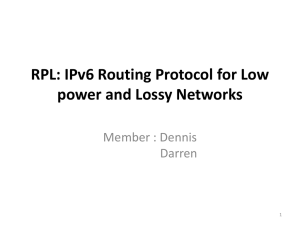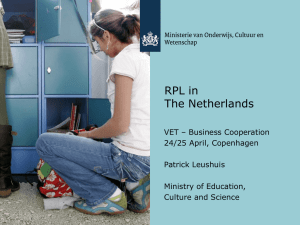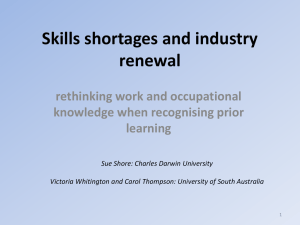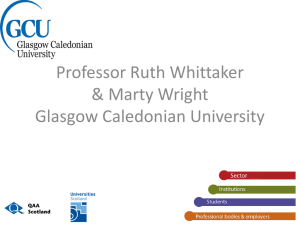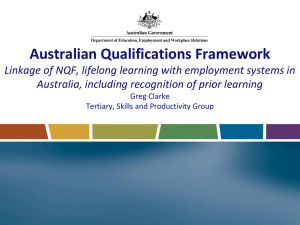The Electronic T2L initiative as a Solution to Improve Short
advertisement
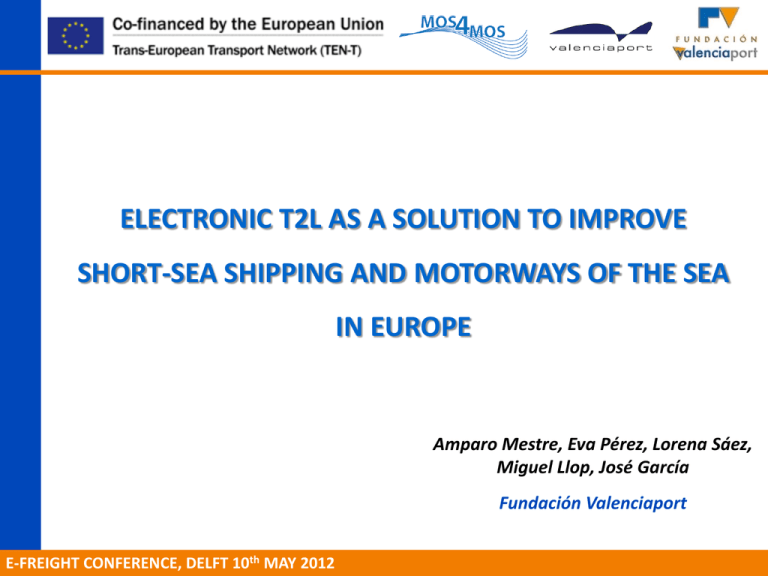
ELECTRONIC T2L AS A SOLUTION TO IMPROVE SHORT-SEA SHIPPING AND MOTORWAYS OF THE SEA IN EUROPE Amparo Mestre, Eva Pérez, Lorena Sáez, Miguel Llop, José García Fundación Valenciaport FUNDACIÓN DEEuropean LA COMUNIDAD PARA LA PROMOCIÓN Y ESTUDIOS COMERCIALES DE VALENCIAPORT Visita del Sr. Luis Valente de Oliveira, Coordinator for Motorways ofINVESTIGACIÓN, the Sea Valencia, 15 Febrero 2010 E-FREIGHT CONFERENCE, DELFT 10th VALENCIANA MAY 2012 CONTENTS 1. MOS4MOS Project 2. Rationality 3. Problem identification 4. Diagnosis 5. Analysis of a possible solution 6. Participants 7. Cost-Benefit Analysis of implementing the electronic T2L 8. Conclusions Electronic T2L as a solution to improve SSS and MoS in Europe - Page 2 1. Introduction Action: Monitoring And Operation Services For Motorways Of The Sea (MOS4MOS) Project Code: 2010‐EU‐21102‐S Duration: 21/March/2011 – 31/May/2012 Co‐financed by: European Union, Trans-European Transport Network, Motorways of the Sea Call 2010 MOS4MOS: Pilot action aimed at preparing the different stakeholders systems to provide integrated and interoperable services for door-to-door Motorways of the Sea (MoS) supply chains General goal: Design and demonstrate a set of prototypes that will provide interoperable monitoring and operation services to companies integrating different MoS corridors The project will contribute to establishing a European/Mediterranean maritime space without barriers by facilitating and simplifying compliance with regulations Consortium: Electronic T2L as a solution to improve SSS and MoS in Europe - Page 3 1. Introduction Initiatives Intra-Community Customs Paperless Controls Automated Gate System Rail-Port Interfaces Electronic IntraCommunity Freight Formalities (ELECTRONIC T2L) Corridor Strategic Planning and Management Port Community Collaborative Solutions Rail e-Ways Multimodal Paperless Workflows Rail Transport Management System Short Sea Consolidation eServices Electronic Ship Formalities Port Traceability Vessel Georeferenced Alerts RFID Traceability of Ro-ro Units RFID Traceability for Automotive Logistics Measures for reducing administrative Electronic T2L as a solution to improve SSS and MoS in Europe -burdens Page 4 2. Rationality Complex and time-consuming administrative procedures based on paper documents and manual processing are a waste of resources and a source of errors that have a negative effect on safety, security and performance. Customs play a key role in the development of innovative solutions to facilitate and simplify all the required formalities in import, export and transit operations while preserving and enhancing the required security, protection and control measures for guaranteeing these operations. Significant progress has been achieved in recent years in e-Customs systems and Maritime Transport Information systems in the EU Member States. For example, the introduction of the “authorised regular shipping service”, since 1998, has substantially simplified sea transport under specific circumstances. Electronic T2L as a solution to improve SSS and MoS in Europe - Page 5 2. Rationality The European Single Market is based on a Customs Union among Member States offering free movement of goods, services, people and capital. The European Customs has removed Customs duties within the EU and created a common external tariff. Goods are initially able to move freely throughout the EU. current situation EU ports represent the line between the EU Customs territory and non-EU Customs territory. Customs controls required to determine the status of goods. Community goods are those: - Obtained in the Customs territory of the European Community; - That having been imported from countries or territories not forming part of the Customs territory of the Community have already been released for free circulation; - Obtained or produced in the Community from goods referred to in the previous statements. - Community goods placed under the internal Community transit procedure maintain their Community status. Electronic T2L as a solution to improve SSS and MoS in Europe - Page 6 2. Rationality current situation The status of goods transported can be proved by the documents enumerated in the Guide to Customs Procedures for Short Sea Shipping SEC (2002) 632. The procedures covered by the cases under consideration are: A T2L/T2LF (copy nº4 of the Single Administrative Document) A properly completed invoice or transport document, relating only to the Community goods, indicating code T2L/T2LF, as appropriate; A shipping company´s manifest, completed and endorsed by the competent office indicating “C” for Community goods. The shipping company´s manifest, where the simplified transit procedures (level 2) are used, indicating the code “C” for Community goods. The use of a shipping company manifest to prove the Community status of goods, at the request of the Shipping Company, must be completed and signed by the relevant Customs office. Electronic T2L as a solution to improve SSS and MoS in Europe - Page 7 2. Rationality current situation Simplified procedures to prove the Community Status of goods Authorised Consignor: person / company authorised by Customs to use T2L and commercial documents as status documents without having to present them for the endorsement of the relevant office. This authorisation allows the company not to present the original forms to prove the Community status of goods. Electronic Shipping Manifest: authorised consignors may be authorised not to provide the manifest serving to demonstrate the Community status of goods until, at the latest, the day after the departure of the vessel and before its arrival at the port of destination. The manifest must be approved by Customs prior to use. Finally a written copy of the manifest must be presented to the Customs of the port of destination. Electronic procedures to prove the Community Status of goods Belgium Estonia Electronic T2L as a solution to improve SSS and MoS in Europe - Page 8 2. Rationality current situation Although simplified procedures exist, in most cases the mechanism for the transport operators to prove the Community status of goods to Customs at the ports of departure and arrival are still manual and paper-based. Port of Exit The general procedure to prove the Community status of goods often requires that paper T2L documents justifying it are generated and presented by an agent to Customs in the Member State of departure, accompanied by a commercial invoice, and these documents are authorised with a stamp and signature. Then, these documents have to be sent from the port of origin to the port of destination. There are several ways used in order to send the documents to their destination. Usually the original documents travel on board the vessel transporting the cargo the documents refer to; or they are posted by mail or express mail. Once the documents arrive, they have to be presented to Customs in the Member State of destination where an additional stamp and a signature is required before the goods can be picked up and leave the port. The original T2L is retained in the Customs Office at the final EU port. Port of Entry Electronic T2L as a solution to improve SSS and MoS in Europe - Page 9 problem identification 3. Problem identification Manual and paper based mechanisms involve costly use of administrative resources, physical displacements, paperwork, additional costs and delays in intra-Community sea transport due to processing time, errors derived from the non-standarized processing, problems due to availability of original documents and difficulties to introduce methods for automating customs controls at ports through the use of electronic means. Today, non-Community goods or goods in transit can leave the port without the need to present any paper as these procedures are completely electronic and automated. Electronic T2L as a solution to improve SSS and MoS in Europe - Page 10 4. Diagnosis Information exchanges Intra-Community freight flows • Scenario 1: Transport of Intra-Community goods by a non-authorised regular service directly linking two EU ports Intracommunity Deliveries Port 1 Port Type EU EU Loading Discharge Community Community - - - DSDT and T2L (JCE, SNR) T2L - - - Movement Goods status at port Port 2 Entry Doc. Port of origin: T2L (Security amm.) Port of destination: T2L + a summary declaration Discharge Doc. Loading Doc. Exit Doc. (Security amm.) • Scenario 2: Transport of Intra-Community goods between two European ports with intermediate calls at non-EU ports The Community goods are transported on the same ship during the entire journey Intracommunity Deliveries Port Type Movement Goods status at port Entry Doc. Port 1 Pto 2 Pto 3 EU Non-EU EU Loading In Vessel Discharge Community Community - ENS - DSDT and T2L (JCE, SNR) T2L - - - (Security amm.) Discharge Doc. Loading Doc. Exit Doc. (Security amm.) The Community goods are transhipped in one of the intermediate port calls Intracommunity Deliveries Port Type Movement Port 1 Port 2 Port 3 EU Non-EU EU Loading Transhipment Discharge Community Community - ENS - DSDT and T2L (JCE, SNR) Loading Doc. T2L - Exit Doc. EXS - Entry Doc. (Security amm.) Discharge Doc. Port of origin: T2L + an Exit Summary Declaration (EXS) will need to be presented in cases where goods will be transhipped to another vessel at the port in the third country. Port of destination: T2L + an Entry Summary Declaration (ENS) (Security amm.)Electronic T2L as a solution to improve SSS and MoS in Europe - Page 11 4. Diagnosis Stakeholders CUSTOMS AUTHORITIES MARITIME CARRIERS / SHIPPING AGENCIES NVOCCs / NEUTRAL FREIGHT CONSOLIDATORS CUSTOMS BROKERS Customs formalities relationships CONSIGNORS AND CONSIGNEES T2L EXPEDITORS NEUTRAL CONSOLIDATORS / NVOCC MARITIME CARRIERS CUSTOMS OF EXIT NEUTRAL CONSOLIDATORS / NVOCC MARITIME CARRIERS CUSTOMS OF ENTRY Electronic T2L as a solution to improve SSS and MoS in Europe - Page 12 5. Analysis of a possible solution The electronic T2L is oriented to facilitate and simplify the compliance with Customs regulations by proving the Community status of the goods transported by sea through electronic means, contributing also to the start-up of other innovative integrated transport solutions. The benefits obtained will have a direct effect in the performance of the overall logistics chain in the Motorways of the Sea. Pursue a win-win approach between public and private stakeholders. To build a European wide Intra-Community freight formalities solution, the proposal will be built upon existing European Customs systems. NTCS System (using for non-community goods) Electronic T2L as a solution to improve SSS and MoS in Europe - Page 13 Source: New Customs Transit System for Europe. European Communities. 2001 5. Analysis of a possible solution Main features of the electronic platform An electronic channel will be available to submit electronic T2L before the departure of the goods via maritime transport. The technical solution will be similar to the one that was adopted for the submission of Entry Summary Declarations (ENS) and Exit Summary Declarations (EXS). A web page associated to the Taxation Agency web site will be available in order to receive the information of the T2L. The information requirements are still subject to changes. A computer assisted risk assessment will be done immediately after the declaration, which will result in the assignment of a green, orange or red circuit. The Web Service that is used will send as a response an electronic message that will assign a number to the T2L by a MRN and will inform about the assigned circuit. If a green circuit is obtained, this will imply the Customs clearance and a control number will be associated. The information about the Customs clearance of the T2L that are submitted electronically will be transmitted to the port authorities so that they can apply the export paperless controls. An electronic channel will be available in order to present the accounting of the Community goods associated to the T2L when they arrive to the border Customs area. Another computer assisted risk assessment will be done immediately after the declaration. The Web Service will send as a response an electronic message that will assign a reference to an exit document (JCE or proof of Community goods). Analogously to the export process, if a green circuit is obtained, a control number will be associated and all the information transmitted to the port authorities so that they can apply the import paperless release procedures. A web system to perform consultations will be available. Electronic T2L as a solution to improve SSS and MoS in Europe - Page 14 6. Participants CUSTOMS PORT ECONOMIC OPERATORS (Simulation) Valenciaport Foundation is the leading partner promoting this initiative. University of Piraeus is providing technical assistance and expertise in the initiative. IFS, Global Maritime Agency and Arkas have provided the required inputs concerning intra-Community freight formalities. Port Authorities of Valencia, Barcelona, Salerno, Livorno and Luka Koper have gathered and analyzed in detail the current situation and identified problems from different economic operators that handle intra-community goods by sea, contact local and national customs authorities when required and built their respective prototypes to demonstrate a feasible solution in each place adapted to the local environment and context. Electronic T2L as a solution to improve SSS and MoS in Europe - Page 15 7. Cost-Benefit Analysis of implementing the electronic T2L Methodology: European Commission (2008): Guide to Cost-Benefit Analysis of Investment Projects. Evaluation Unit of the European Commission. Directorate of Regional Policy. Brussels, July, 2008. Main changes that the implementation of the e-T2L would bring to the current operational processes of each stakeholder have been analysed interviews and fieldwork. Investments and potential increases and decreases in costs have been measured. An application has been programmed that is capable of dynamically calculating the main cost-benefit results that would stem from the implementation of the e-T2L initiative. Such results include: economic Net Present Value (NPV), economic Internal Rate of Return (IRR), an investment recovery time (pay-back period). A stochastic model of the cost-benefit analysis has been constructed: an average has been established for each parameter (the value that displays the highest frequency) along with a confidence interval using the minimum and maximum expected values for this factor. By stochastically modelling each of the parameters, it is possible to calculate how sensitive the final economic NPV, IRR and pay-back year are to each and every factor included in the estimation and the variability interval with an associated probability distribution for each result. 1,000,000 different scenarios have been simulated in this study. Analysis of the results of the cost-benefit analysis and the sensitive analysis. Electronic T2L as a solution to improve SSS and MoS in Europe - Page 16 7. Cost-Benefit Analysis of implementing the electronic T2L Hypotheses: Life-span of the project: 20 years Ports under study: Valencia, Barcelona and Salerno Average inflation rate: 2% Discount rate for public sector entities: 5%; discount rate for private companies: 10% Annual growth of intra-Community traffic: 2% Annual maintenance cost (software): private bodies: 10%; public bodies: 5% Procedures of proving Community status of goods: paper T2L 60%; “C Manifest” 15%; 25% authorised consignors Container intra- Community traffic (2010): Valenciaport: 70,377; Barcelona: 55,159 and Salerno: 70,000 Percentage of consolidation: Valencia and Barcelona: 10%; Salerno: 3%. 8 T2L per consolidated container and 1 T2L per 2 full container. Shipping agencies: Valenciaport: 57; Barcelona: 40 and Salerno: 12. NVOCC: Valenciaport: 5; Barcelona: 7 and Salerno: 1. Electronic T2L as a solution to improve SSS and MoS in Europe - Page 17 7. Cost-Benefit Analysis of implementing the electronic T2L Hypotheses: Percentage of implementation of the initiative: 95% Percentage of errors in current processes: 1%. Time solving errors: 30 minutes Average procedure time (current processes): NVOCC: 9 minutes per T2L Shipping Agencies: 9 minutes per T2L; 3.6 minutes when using C Manifest and 0 minutes when acting as an authorised consignor Customs: 4.8 minutes per T2L Average procedure time with electronic system: 0 minutes. Labour cost: 14.46 Euros/hour Cost of printing paper T2L: 0.01 Euros Average cost of transport of the T2L to Customs (to be signed and stamped): 0.16 Euros Electronic T2L as a solution to improve SSS and MoS in Europe - Page 18 7. Cost-Benefit Analysis of implementing the electronic T2L Electronic T2L as a solution to improve SSS and MoS in Europe - Page 19 7. Cost-Benefit Analysis of implementing the electronic T2L SHIPPING AGENCY NVOCC IRR (%) - 64,11% CUSTOMS 0,57% PORT AUTHORITY TOTAL - 17,63% Electronic T2L as a solution to improve SSS and MoS in Europe - Page 20 7. Cost-Benefit Analysis of implementing the electronic T2L Electronic T2L as a solution to improve SSS and MoS in Europe - Page 21 8. Conclusions The electronic T2L has been included as one of the 22 proposals in the Spanish Action Plan for the Reduction of Administrative Burden. This Action Plan was approved by the Agreement of the Spanish Council of Ministers signed on 16 September 2011 (Consejo de Ministros, 2011). Spanish Customs has carried out their own estimate of the savings that would be generated by the implementation of the electronic T2L using the Simplified Method to Measure Administrative Burden and the Impact of its Reduction. If all Spanish ports and port communities used the new electronic T2L system enforced by Spanish Customs, savings would amount to 39 million Euros. Electronic T2L as a solution to improve SSS and MoS in Europe - Page 22 8. Conclusions The electronic T2L would be extremely useful for Customs Authorities as they are responsible for developing innovative procedures and solutions to facilitate and simplify all the required formalities in intra-Community flows while preserving the required security. Validate additional measures for extending some of the advantages of EU authorised regular shipping services, allowing the creation of virtual bridges carrying goods between ports within the EU. Facilitate and simplify Customs controls at ports while enhancing security. Reduce existing bottlenecks and delays inherent to manual processes Introduce new methods for simplifying formalities for ships arriving and/or departing to/from European ports without reducing the level of security and safety. Foster the adoption and recognition of electronic documentation and the use of electronic data transmission systems. Eliminate the risks, latency and quality issues common to manual verification of documents at customs controls. Make intra-Community sea transport as simple and easy as intra-Community road transport is. Electronic T2L as a solution to improve SSS and MoS in Europe - Page 23 Thank you for your attention! Amparo Mestre Fundación Valenciaport amestre@fundacion.valenciaport.com FUNDACIÓN DEEuropean LA COMUNIDAD PARA LA PROMOCIÓN Y ESTUDIOS COMERCIALES DE VALENCIAPORT Visita del Sr. Luis Valente de Oliveira, Coordinator for Motorways ofINVESTIGACIÓN, the Sea Valencia, 15 Febrero 2010 E-FREIGHT CONFERENCE, DELFT 10th VALENCIANA MAY 2012




